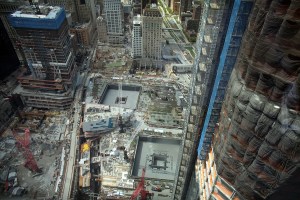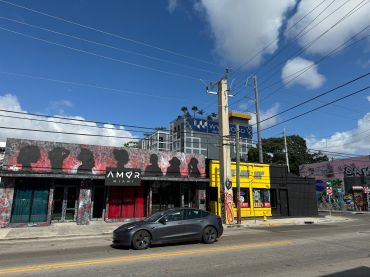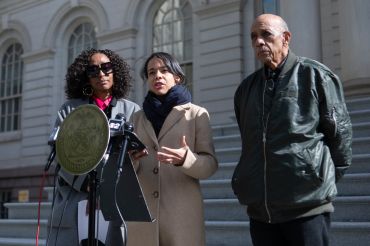PAC Follies at Trade Center Site: Whatever Became of That $100 Million?
By W.M. Akers May 18, 2011 12:11 am
reprints At Ground Zero the memorial trees are springtime-green and the waterfalls are up and running, but there remains much to do. Besides the various incomplete towers, slow progress continues on the transit hub that fills the space beneath the site, where the Port Authority is laying the foundation for another long-delayed project: the Performing Arts Center. After nearly a decade of drama, the PAC refuses to die.
At Ground Zero the memorial trees are springtime-green and the waterfalls are up and running, but there remains much to do. Besides the various incomplete towers, slow progress continues on the transit hub that fills the space beneath the site, where the Port Authority is laying the foundation for another long-delayed project: the Performing Arts Center. After nearly a decade of drama, the PAC refuses to die.
Part of the site’s design since the original Master Plan, the PAC is a vision of cultural life in Lower Manhattan that no one seems to be in charge of. But it has friends in high places: namely David Emil, president of the Lower Manhattan Development Corporation, and Julie Menin, chairwoman of Community Board 1. Last year those two joined forces to send $100 million of LMDC money to the project, legitimizing something that had become a punch line. Seven months since that booster shot, however, progress has stalled, and Ms. Menin’s “downtown Lincoln Center” is as far away as ever.
Ms. Menin described the PAC as “a cultural mecca” that could combine with the 9/11 Memorial to form “a Museum Mile for lower Manhattan.” The current plans, based on a two-year-old Frank Gehry design, feature a 1,000-seat theater ringed by several smaller venues; it’s been seen as an attempt to bring sense to a downtown scene that has been called “a kingdom of minor museums.”
The cost? $450 million. The time frame? Eventually. The obstacles? Legion.
Ms. Menin began lobbying for the PAC in earnest last year, as part of a campaign to cajole the LMDC into releasing the last of the $2.78 billion in relief funds allocated by Congress after the Sept. 11 attacks. Her mantra: “It’s my belief that the LMDC should get the money out immediately–as in tomorrow.” Last April, upon learning of $150 million in unspent funds, she flew into a civic-minded rage.
She penned an op-ed for the Daily News that sparked a brawl with Con Ed. (“I helped find $150 million,” it began modestly, “and it belongs to you.”) The utility claimed to be owed the money for work done during the 9/11 recovery, and at a fiery community board meeting it threatened a $50 rate hike if the cash went elsewhere. Con Ed lost, the PAC got its $100 million, and the city nixed the hike.
Despite that victory, there has been no tangible progress since autumn. Nine years after Congress first handed it over, the money continues to sit on the LMDC books, earning no interest. The LMDC and Emil, as its president, are often scapegoated for delays at Ground Zero, but the PAC’s woes aren’t their fault. The root cause of its problems is that it simply doesn’t exist. The PAC has no board of directors to accept the $100 million and no organized nonprofit to which it can be donated. At the moment, no one appears to be taking charge. Since plans for the International Freedom Center were abandoned amid a hail of controversy in 2005, few in the city have been willing to expend political capital on the arts at Ground Zero, preferring instead to focus on the Memorial and Museum, a project that over the past year has started to look like a sure thing.
When asked about the PAC, the Memorial Foundation points to the LMDC, which tosses the hot potato to the mayor’s office, which passes it on to the Port Authority, which lobs it back at City Hall. “It’s a city project,” said Steve Coleman, a spokesman for the Port Authority, insisting that though the Port Authority may build the foundation, it is not responsible for whether or not anything goes on top of it.
The truth is that, like everything at Ground Zero, responsibility is divided, this time between the Memorial Foundation and the Department of Cultural Affairs, headed by Kate Levin. That is according to an old agreement between the LMDC, the mayor and the Paterson administration, which also stipulates that a PAC board of directors must be named by the end of 2011. City hall Deputy Press Secretary Andrew Brent declined to give details, but said that the process was “underway,” and that the PAC’s board of directors “will certainly be up and running before the end of the year.”
Meanwhile, the Port Authority works on the PAC’s foundation despite lingering questions about where the building should actually go. It has long been planned for Site 1B–currently home to the temporary PATH station–but some PAC supporters would prefer to see it at the Deutsche Bank site, just south of the memorial park. Building there, away from the problematic transit hub, would save $125 million and allow for construction to begin sooner. As it stands, the PAC must wait for the hub’s completion–not scheduled until 2014 in even the most optimistic estimates–which would put the project in a race with the Second Avenue Subway for New York’s most slothful civic undertaking. Relocating the PAC, however–to return to the project’s Kafkaesque circle of kinks–is a question that can only be asked once a board of directors is in place.
It is a nasty muddle, but those who work at Ground Zero are expert muddle-navigators, Mr. Emil chief among them. The LMDC president, who has a stately bearing and a voice like actor Alan Alda’s, remains passionate about the PAC, which he described as “the crucial creative, forward-looking component of the rebuilding of the World Trade Center site.” The memorial is vital, he said, but “not complete unto itself.”
“It has to have a living, creative component that celebrates all aspects of flourishing life,” he said. “The PAC offers that.”
For all it lacks, the PAC has $100 million, a brand-name architect and, in the Joyce Theater, at least one high-profile tenant. The dance institution began planning a move downtown before the PAC was first dreamed up and has stuck with the idea even as the PAC’s other original tenants–the Drawing Center, the Signature Theatre, and the International Freedom Center–pulled out under extreme media pressure.
“We are very patient people,” said the Joyce’s executive director Linda Shelton.
Even if construction starts in 2014, getting downtown before its present Chelsea lease expires will be a tight squeeze for the Joyce. Nevertheless, Ms. Shelton remains confident. “We feel that window closing a little,” she said without a hint of panic in her voice.
If additional arts groups sign up for the PAC, Ms. Menin’s dream of a downtown Museum Mile may not be so farfetched. When the 9/11 Memorial and Museum fully opens next year, it is expected to draw between five and seven million annual visitors–the kind of foot traffic that would presumably be attractive to potential PAC tenants. Should the center start to build momentum, unsettled cultural institutions across the city may well cast in their lot.
The Gotham Chamber Opera, for example, is already in talks to perform at St. Paul’s Church, across from the World Trade Center site, and is looking for a downtown base of operations. David Bennett, the opera’s executive director, doesn’t shy away from the national media scrutiny that has dogged so many attempts to bring culture to the site. “That kind of thing isn’t going to continue forever,” he said. “It might even be a little bit of a buzz!”
But that is at least several years away. For now, the steady rhythm of jackhammers is the only music at Ground Zero.
editorial@observer.com


